EU Calculations
How to design a wood column to EN1995
First, we enter the key properties of our column:
Background
The EU timber columns calculator can be used to calculate both the demands as well as the resistance of a straight column.The analysis capabilities include:
- Point Axial and Lateral forces
- Point Moments in the major and minor axis (excluding torsion)
- Line Loads (including linearly varying)
- Distributed Loads (including varying tributary width). For details on tributary widths, refer article 170-what-is-tributary-width
- ULS: Section Bending Moment Capacity (EN 1995-1-1:2004 Cl 6.1.6)
- ULS: Shear Resistance (EN 1995-1-1:2004 Cl 6.1.7)
- ULS: Section Compression And Bending (EN 1995-1-1:2004 Cl 6.2.3 & 6.2.4)
- ULS: Compression / Combined with Bending: Flexural Buckling (EN1995-1-1:2004 Cl 6.3.2)
- ULS: Bending or combined bending & compression: Lateral Torsional stability (EN 1995-1-1:2004 Cl 6.3.3)
- SLS: Deflection analysis
- Softwood and Hardwood Timber
- Laminated Veneer Lumber (LVL)
- Glue Laminated Lumber
Tutorial
In this worked design example, we will go through the design process of a single-story stud wall. It is pinned at the top and bottom (restrained in translation, but not in rotation about the z-z or y-y axis). It is for a residential building and is exposed to Service Class 2. A central batten provides restraint for bending about the Z-axis, but not in the Y-axis (refer snapshot below).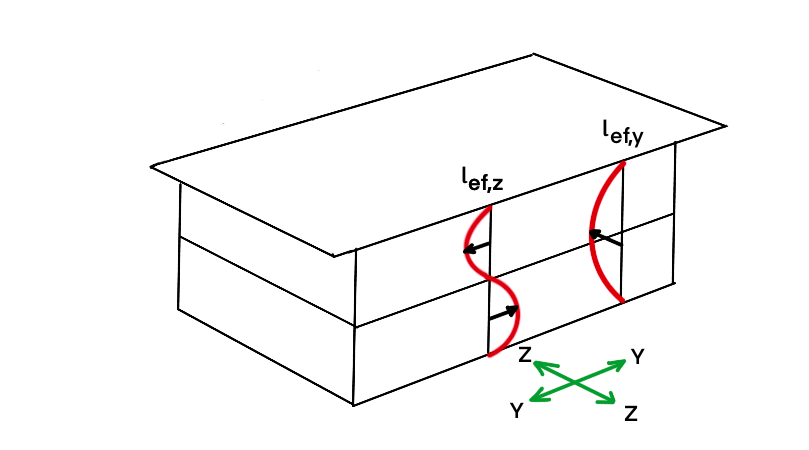
1. Create a Calculation
When adding a new timber column calculation, you can select between various types of residential walls. The sheet and calculations for each are the same, however, some default values and criteria, such as deflection limits and centre to centre spacing, have been made specific to each column type. For this example, we will select an exterior stud wall.
2. Entering our key properties
Quick Tip - If you’re ever unsure what something means in ClearCalcs, simply click the field label for references, checks, conditionals, and descriptions. For example: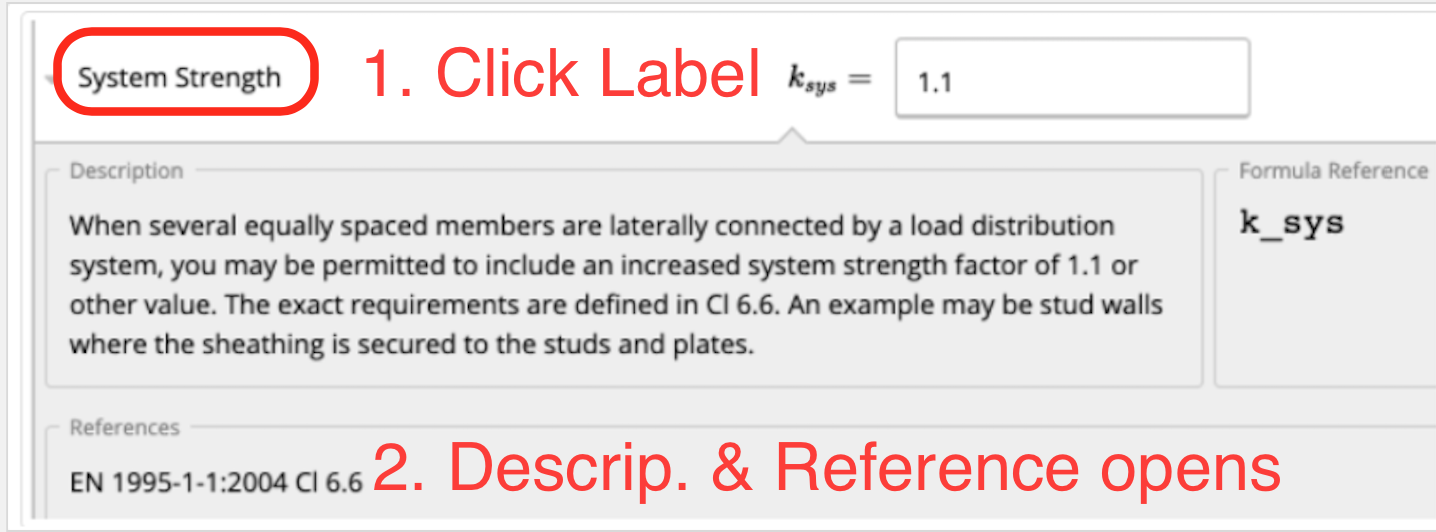 First, we enter the key properties of our column:
First, we enter the key properties of our column:
- Member Type - Clicking “Select” will open a list of all properties and allow you to select timber sizes from a database, or custom dimensioned timber. Refer to related article Quickly finding the best section with the member selector. We want to use custom dimensions Softwood Timber of grade C20, and select a dimension based on past experience:

- Total Column Length - Select the length between the start and end of the column. We select 3500 mm.
- Critical Buckling Lengths - We are confident that the column has adequate lateral bracing at the batten (braced about z-z axis as per diagram above), so the length between lateral restraints is equal to half the column length (1750 mm).

- Position of Supports from Bottom - The support conditions may be at any position along the column, and can include 1 or more supports. A cantilever can be created on either end by moving the support condition away from “0” or the “Total Span Length”. In our case, the default simply supported position is adequate.

3. Load Details
ClearCalcs offers a number of ways to enter loads, to suit a range of uses. These include:- Distributed Loads (kPa)
- Line Loads (kN/m)
- Point & Moment Loads (kN or kNm)
- Enter the start and end location. Note you can type the ID of any variable, or even include a formula in each input cell. In our case “L” is sufficient.
- Enter the start and end load width. Refer 170-what-is-tributary-width for further details.
 Point & Moment Loads: Because we selected the “Exterior Stud Wall” type of timber column, ClearCalcs auto-fills approximate loading, although the weight of roofs or upper stories may vary significantly so we will need to amend these. We will add a load at the top of the column “L” and ClearCalcs automatically calculates the value.
Quick Tip: If the roof is designed within ClearCalcs, you can load link the reactions directly into the top of the stud either as an effective “Line Load” (for regularly spaced joists) or as individual concentrated loads. Refer 24-linking-reactions-between-beams-and-columns-load-path-tracking. This prevents having to re-type the loading and avoids errors.
Point & Moment Loads: Because we selected the “Exterior Stud Wall” type of timber column, ClearCalcs auto-fills approximate loading, although the weight of roofs or upper stories may vary significantly so we will need to amend these. We will add a load at the top of the column “L” and ClearCalcs automatically calculates the value.
Quick Tip: If the roof is designed within ClearCalcs, you can load link the reactions directly into the top of the stud either as an effective “Line Load” (for regularly spaced joists) or as individual concentrated loads. Refer 24-linking-reactions-between-beams-and-columns-load-path-tracking. This prevents having to re-type the loading and avoids errors.
 Self-weight may be automatically calculated using the self-weight toggle.
Self-weight may be automatically calculated using the self-weight toggle.
 4. Design Criteria and National Annex Parameters
EN1995-1-1 identifies a number of clauses that may be specifically overridden by national annexes, which are summarised in the Foreword under Section “National Annex for EN 1995-1-1”. ClearCalcs offers a handy section “Design Criteria & National Annex Parameters” that gives access to review or quickly edit these.
Service Class - The service class selection affects the duration factors k_mod and the deformation factor k_def. We will set this to Service Class 2 in accordance with British National Annex EN1995-1-1:2004+A1:2008 Table NA.2 (External uses where the member is protected from direct wetting). You will see a quick overview of of the selected factors:
4. Design Criteria and National Annex Parameters
EN1995-1-1 identifies a number of clauses that may be specifically overridden by national annexes, which are summarised in the Foreword under Section “National Annex for EN 1995-1-1”. ClearCalcs offers a handy section “Design Criteria & National Annex Parameters” that gives access to review or quickly edit these.
Service Class - The service class selection affects the duration factors k_mod and the deformation factor k_def. We will set this to Service Class 2 in accordance with British National Annex EN1995-1-1:2004+A1:2008 Table NA.2 (External uses where the member is protected from direct wetting). You will see a quick overview of of the selected factors:
 Default Load Duration Assignments per Load Combination: ClearCalcs shows also what modification factor has been assigned to each load combination. Example duration factors are pulled from Table 2.2, and may be altered in the Project Default tab in the sidebar. Note that all accompanying variables are applied at the same time e.g. G + QI + all a ccomp. factors ( S + W + T).
Default Load Duration Assignments per Load Combination: ClearCalcs shows also what modification factor has been assigned to each load combination. Example duration factors are pulled from Table 2.2, and may be altered in the Project Default tab in the sidebar. Note that all accompanying variables are applied at the same time e.g. G + QI + all a ccomp. factors ( S + W + T).
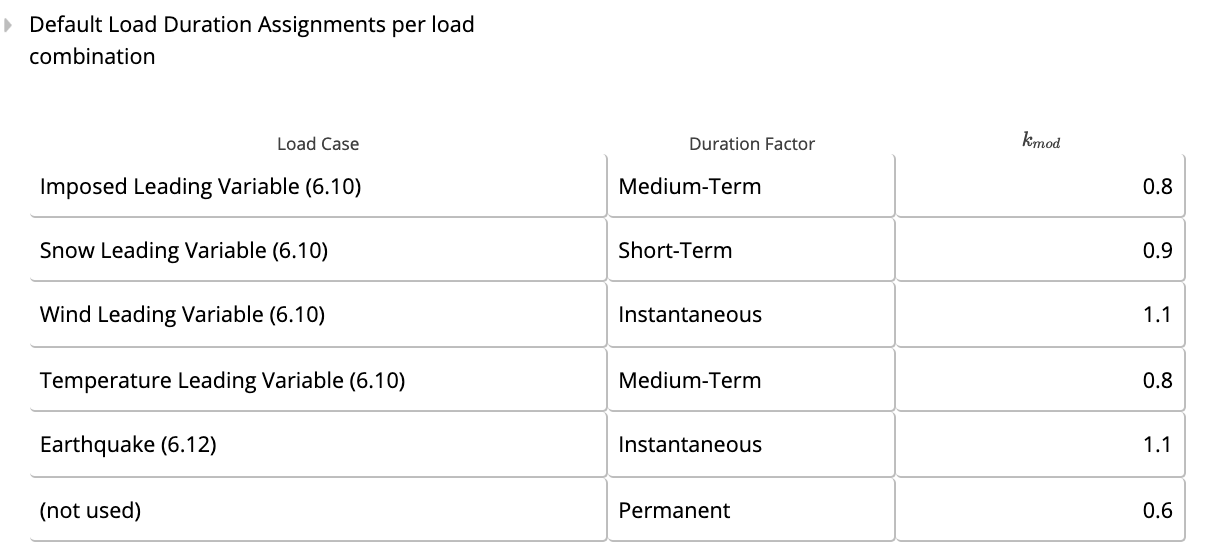 Partial Factor / Influence of crack width: These factors will infrequently require amending based on National Annex requirements. In our case, the British annex is consistent with EN1995-1-1 for solid timber sections and we can leave as is.
Partial Factor / Influence of crack width: These factors will infrequently require amending based on National Annex requirements. In our case, the British annex is consistent with EN1995-1-1 for solid timber sections and we can leave as is.
 Deflection limits: These depend on the national annex and the use of the structure. In the UK annex Table NA.5 BS EN1995-1-1:2004+A1:2008 only beam deflection limits are given. In our case, we know that the wind load will not cause significant lateral bending and we can ignore the calculation. We may set arbitrarily high deflection limits to ensure the check will not exceed any deflection requirements:
Deflection limits: These depend on the national annex and the use of the structure. In the UK annex Table NA.5 BS EN1995-1-1:2004+A1:2008 only beam deflection limits are given. In our case, we know that the wind load will not cause significant lateral bending and we can ignore the calculation. We may set arbitrarily high deflection limits to ensure the check will not exceed any deflection requirements:
 System Strength: We have more than 3 parallel studs, so may make use of the System Strength Factor. To refresh ourselves on the relevant clause, we click the triangle to the left of the label to double-check on the clause containing this requirement.
System Strength: We have more than 3 parallel studs, so may make use of the System Strength Factor. To refresh ourselves on the relevant clause, we click the triangle to the left of the label to double-check on the clause containing this requirement.
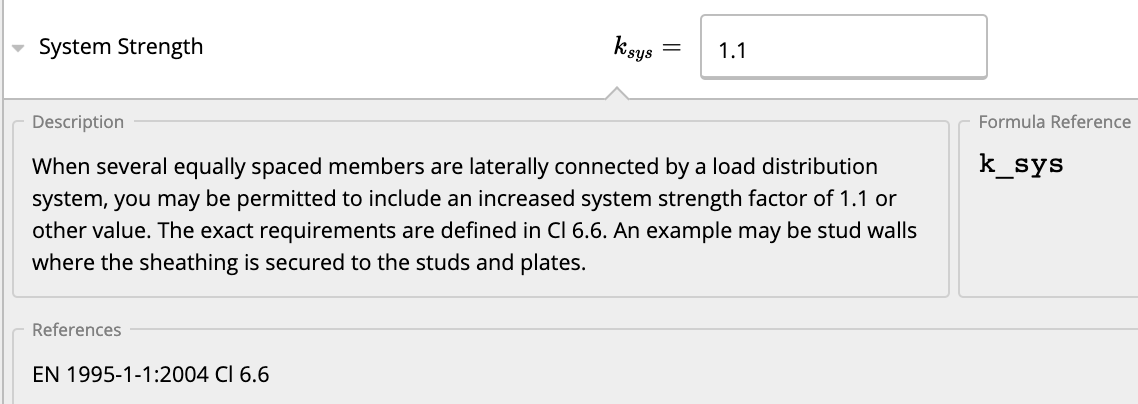
- Section selection
6. Summary of results and internal force diagrams
Once we’ve got our column design, we can quickly glance at relevant values to make sure everything corresponds to what we’d expect. On the right panel is the summary section, where we find things such as the critical moment demand and capacity, shear, moment and deflections. Where a calculation for lateral-torsional buckling was required based on Eurocode criteria, totals will also be shown. Where buckling does not govern (stocky column), the cross-section interaction checks will be shown instead. We can also look at the shear, bending and deflection diagrams to make sure they correspond to what we anticipate. Not the envelope lines for bending and shear do not consider the interaction equations for axial and bending results therefore should only be used as a guide.
We can also look at the shear, bending and deflection diagrams to make sure they correspond to what we anticipate. Not the envelope lines for bending and shear do not consider the interaction equations for axial and bending results therefore should only be used as a guide.
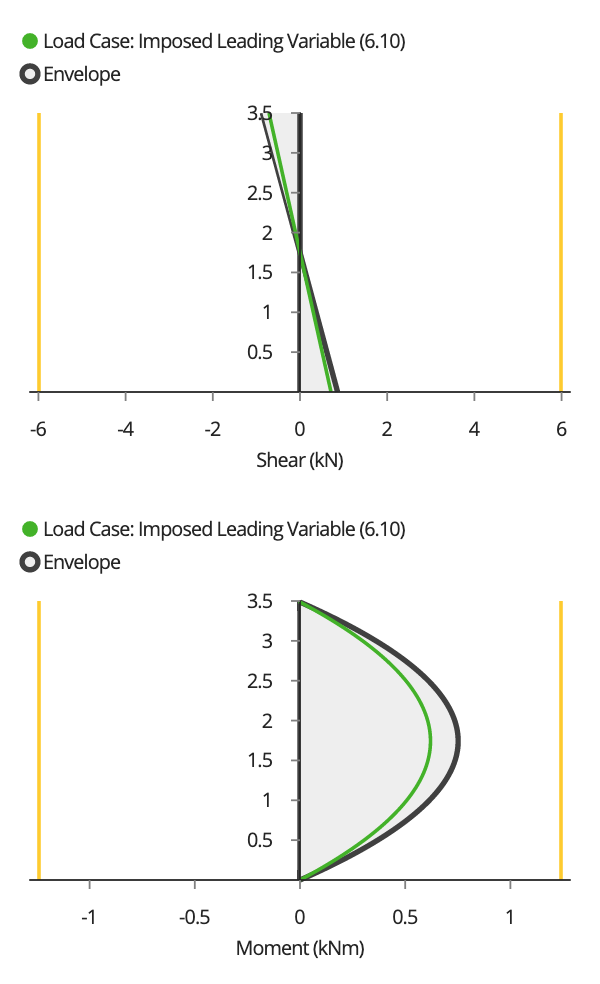
We can also see the “factored” loads applied for each load combination. We can see that the G = 0.5 kN and QI = 2 kN loads were factored by 1.35 x and 1.5x respectively giving us 3.68 kN total factored axial load. Also, the distributed loads and self-weight were converted to a line load and factored.
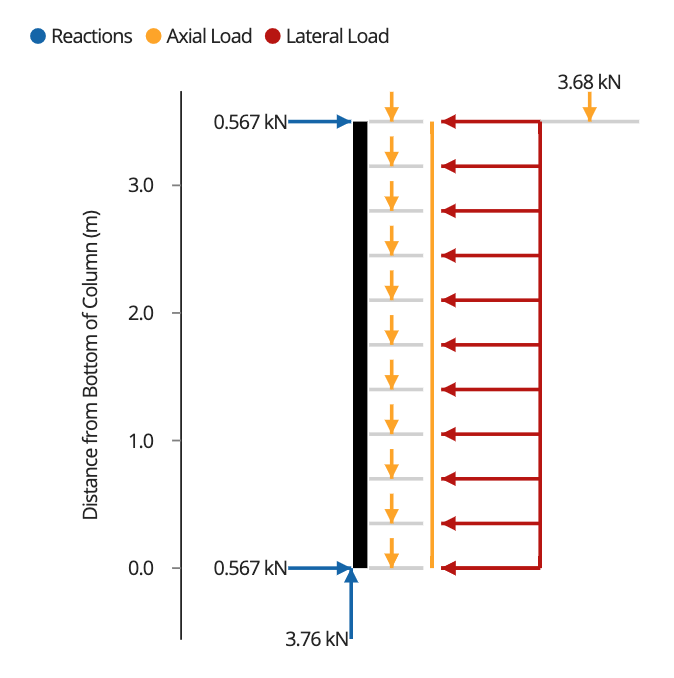
7. Printing and Member Schedule
Printing: We can now print our fully designed. Before finishing, let’s write a Comment to ourselves. This will appear in the printout.
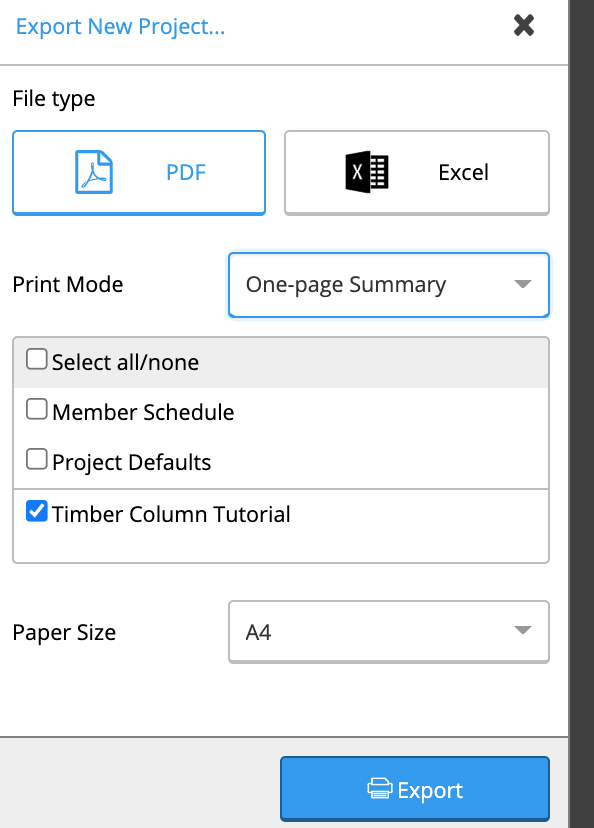 And here is the printout ready for submission!
And here is the printout ready for submission!
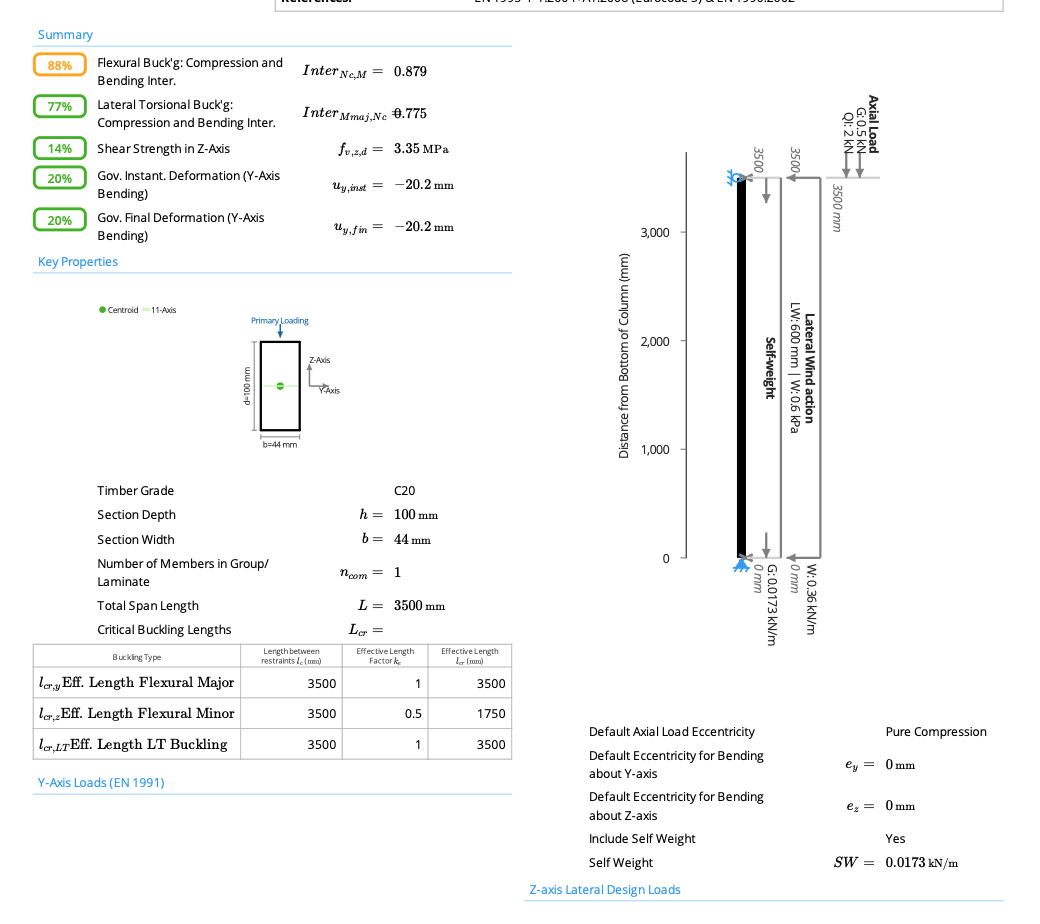 Member Schedule: ClearCalcs provides a handy Member Schedule that can be viewed from the sidebar and/or printed.
Member Schedule: ClearCalcs provides a handy Member Schedule that can be viewed from the sidebar and/or printed.

A more in-depth look
Detailed Mode:
While the previous steps are all that is required to design our column, it may be desirable to see the steps in more detail. ClearCalcs fully exposes all code calculations to see every step of the process employed in any of our calculators. For instance, we can go look at how flexural buckling checks are calculated. Some calculations are hidden for clarity, however, they can be made visible by selecting “Detailed” mode. See 163-how-to-view-all-detailed-calculation-steps. For example, see some key inputs for flexural buckling found by scrolling down in the left column, and clicking on the heading to expand.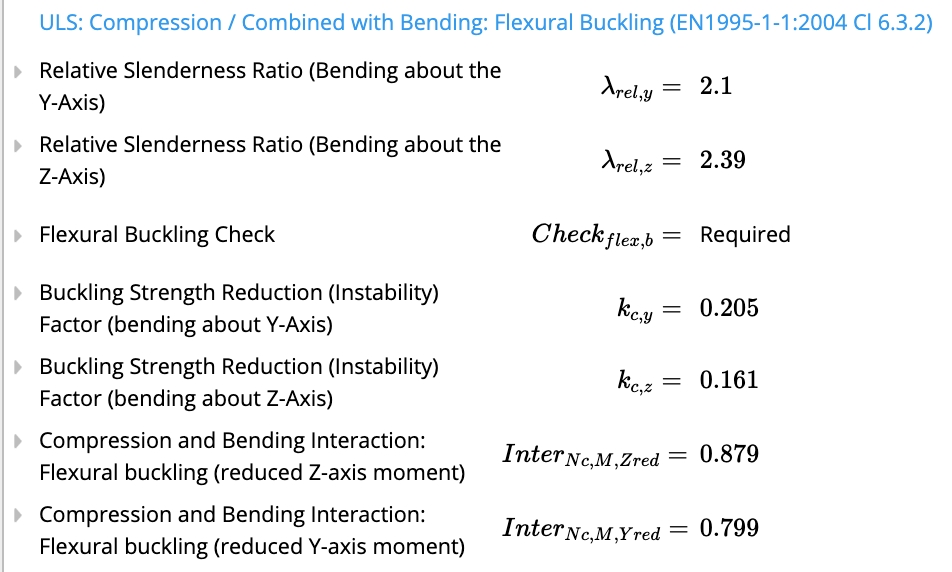
Multiple Laminations
Users may design custom sections, where the database doesn’t have the exact size and grade you need. In addition, any timber section can be stacked horizontally (laminated), to act as one composite member.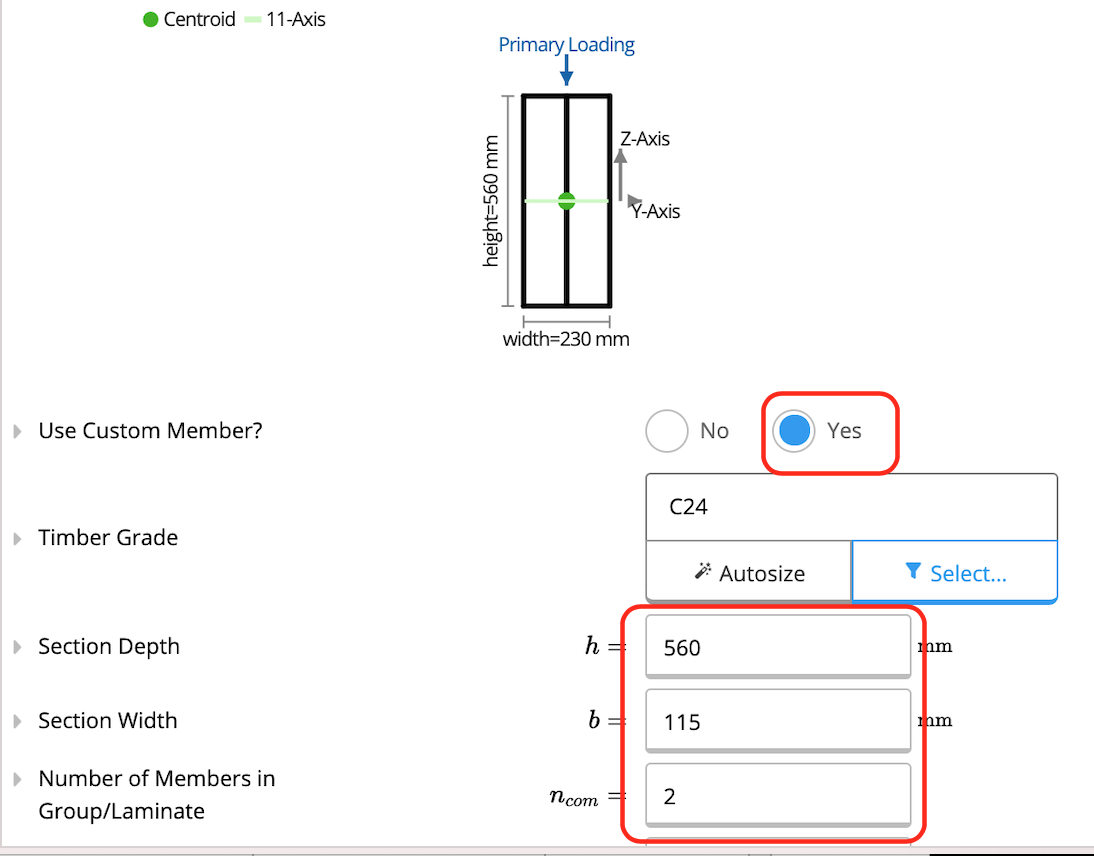
Axial Load Eccentricity
Do you sometimes need to check for the axial load being positioned eccentrically to your column, and thereby inducing some bending moment? This is easy to do by selecting from various predefined options in “Default Axial Load Eccentricity”, or even assigning eccentricities per load case. This concludes our short tutorial on designing a timber column per EN1995-1-1:2004 with ClearCalcs.
This concludes our short tutorial on designing a timber column per EN1995-1-1:2004 with ClearCalcs.
